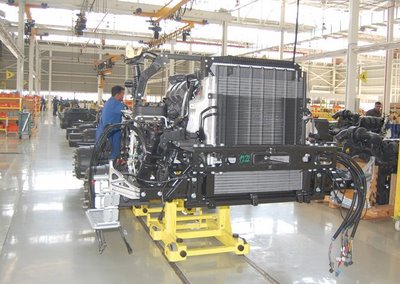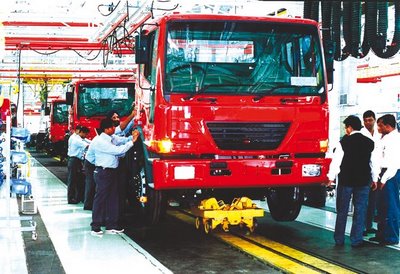The agency expects volumes to stabilise over the first half of 2009, although at lower levels than in 2008. This will result in negative y-o-y growth rates until end of the year, when the high base effect is corrected. Whilst the long-term fundamentals of the sector remain strong, the reversion to long-term growth rates around 10-12 per cent for cars and 8-10 per cent for CVs is likely to take longer and be slower than in earlier cycles. The industry volume graph over the medium-term is expected to follow more of an “L”-shaped pattern rather than the “U”-shaped pattern seen through the earlier positive cycle. Further, exports have been unable to provide the earlier cushion over 2008 due to a severe slowdown in their respective markets.
Growth rates have traditionally been more volatile for CVs than for cars – a trend being indeed witnessed in the current slowdown. Domestic CV sales declined by 9.5 per cent in April-November 2008, compared with the same period in 2007, to 298,208 units. However, the full impact of the deceleration will only be seen in the April-March financial year-end figures, as the y-o-y declines continue through the first quarter of 2009. Although CV makers have been offering discounts, it has not been enough to offset the current negatives being faced by freight operators – a reflection of the current economic environment.
Operators faced pressures at the end of the second half of 2008 due to the following factors:
* Pressure on freight volumes due to lower freight demand from exporters, slower growth in IIP, and competition from railways for large commodities. This, coupled with increased capacity built up over the cycle, has led to lower capacity utilisation.
* Operators have also faced severe cost pressures due to higher fuel and financing costs, putting further pressure on margins. However, with excess capacity, they have relatively limited ability to pass these costs on to their customers. This is seen in the softer trends in freight indices. However, the recent softening in interest rates and reduction in fuel costs could boost operators’ liquidity, although with a lag effect.
* Operators are also facing issues with regard to the higher cost of credit, and availability of finance with regard to new truck purchases. The problem is compounded by Fitch’s expectation of higher NPL levels across truck financiers, which could further hamper credit availability. Fitch notes that stable CV demand remains contingent upon a stable economic environment, including continued positive growth in freight volumes and stabilisation of freight rates at higher levels. This will likely lead to an improvement in the financial and liquidity position of operators. Demand could also benefit towards end-CY09 from the advancement of purchases in anticipation of the new emission norms in April 2010, although this will be one-time in nature similar to that of the overloading ban two years ago. Fitch expects the above demand drivers to stabilise over the year, and anticipates a marginal soft recovery to start towards the end of 2009.
Fitch notes that stable CV demand remains contingent upon a stable economic environment, including continued positive growth in freight volumes and stabilisation of freight rates at higher levels. This will likely lead to an improvement in the financial and liquidity position of operators. Demand could also benefit towards end-CY09 from the advancement of purchases in anticipation of the new emission norms in April 2010, although this will be one-time in nature similar to that of the overloading ban two years ago. Fitch expects the above demand drivers to stabilise over the year, and anticipates a marginal soft recovery to start towards the end of 2009.
Although some relief can be expected over the near-term from price cuts from vendors, as well as softer input prices (steel, copper and aluminium), this will benefit OEMs only once the current raw material inventories purchased at higher costs are liquidated.
Slower demand, coupled with lack of financing access by dealers, has put pressure on the working capital cycles of most OEMs. Slower demand has led to inventory pileups both at the dealer level and at the OEMs’ own plants. However, car and CV makers have been taking corrective measures, primarily in the form of cutting back on production to prevent further inventory pile-ups. But these production cuts have taken place with a lag effect, resulting in stretched working capital cycles for most OEMs and putting further pressure on their liquidity.
As production and dispatches continue to lag market demand, Fitch expects the situation to correct itself over the short term. OEMs are stretching their utilisation levels of working capital limits, as well as stretching their suppliers’ payment terms to finance this liquidity mismatch.
Most OEMs are likely to face substantial pressure on operating cash flows due to slower demand, lower margins and higher working capital requirements. This will in turn put pressure on their liquidity and credit metrics over the short to medium term. Interest coverage is likely to remain under pressure due to a combination of higher working capital utilisation, increased interest costs and Fitch’s expectation of negative free cash flow (FCF) for the sector. Fitch notes that the impact on credit profiles has been more severe for pure-play CV makers, which have faced the brunt of the impact of the slowdown.
Whilst most OEMs are currently implementing large-scale expansion, some of the greenfield projects are being scaled down/deferred. This could stem the extent of deterioration. That said, a substantial part of their expansion is nondiscretionary in nature, e.g., critical capex required for new model launches, and long-term strategic initiatives. Thus, whilst the extent of capex will remain large in relation to operating cash flows, the size of these investments is likely to be lower than that projected by Fitch in 2008. The agency expects the lower growth to translate into higher negative FCF in 2010 than anticipated earlier, which will exert additional pressure on operating metrics.
